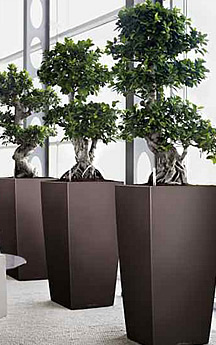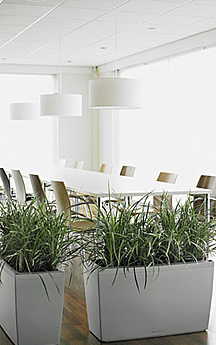Workplace Health
Buildings can cause problems
We often hear the term "sick buildings"; these are buildings that have either poor ventilation or badly serviced air-conditioning and contain construction materials and/or furnishings that produce noxious emissions. Most commercial buildings constructed during the past three decades are also more tightly sealed than older buildings, thus concentrating noxious emissions.
Most people in developed countries work, shop and relax in these "sick buildings". "Sick buildings" are a potential health hazard!
Living plants can help solve the problems associated with "sick buildings". The correct placement of suitable plants will reduce toxicity levels in poorly ventilated buildings and increase the effectiveness of existing air conditioning systems.
NASA Research Proves Plants Control Indoor Air Pollution
NASA established that indoor plants filter at least three chemicals: benzene, formaldehyde and trichloroethylene. Low levels of these chemicals are released into virtually every modern environment. benzene is a solvent used in petrol, ink, oil, paint, plastic and rubber. Formaldehyde is present in virtually all indoor environments: urea-formaldehyde resins are used in foam insulation, particle board and pressed-wood products; it is also present in tobacco smoke, natural gas and kerosene. Trichloroethylene is used in metal degreasers, dry-cleaning solvents, inks, paints, lacquers, varnishes and adhesives.
Recent environmental studies have shown that air pollution indoors is a major cause of public exposure to air pollution. Sustained exposure to these chemicals causes chronic health problems. Living plants do reduce the levels of these and other chemicals.
Chemicals (per cent) removed by plants from a sealed chamber during 24 hr period:
| Formaldehyde % | Benzene % | Trichloroethylene % | |
|---|---|---|---|
| Dracaena massangeana (Happy Plant) | 70 | 21.4 | 12.5 |
| Dracaena deremensis (Janet Craig) | 50 | 70 | 20 |
| Ficus Benjamina (Weeping Fig) | 47.4 | 30 | 10.5 |
| Spathiphyllum (Peace Lily) | 50 | 80 | 23 |
| Scindapsus aureus (Golden Pothos) | 67 | 67 | 9.2 |
Many other plants will also improve indoor air quality. NASA is continually testing other plants. Interior Plantscapers can advise on the best plants for you to use.

Living Plants Promote Health
Living plants convert the carbon dioxide we exhale to oxygen, which is vital to our survival. Recent NASA experiments in the USA prove that living plants do even more to cleanse and revitalise the air we breathe. They found that plant leaves and roots and soil bacteria work together to take in airborne pollutants, process them and then release clean air. As well, living plants release moisture, providing a natural means of maintaining correct humidity levels.
The Australian Situation
In Australia up to 75 per cent of buildings are affected by "sick building" syndrome. A leading Australian architect recently warned that building owners are rendering themselves liable to workplace health and safety based litigation owing to their not addressing the problems of indoor air pollution.
The Australian Society of Environmental Medicine reported recently that air-conditioning can trigger chemical sensitivity and respiratory illness and that early modern air-conditioning systems do not recycle fresh air adequately. Re-used air spreads bacteria, viruses and chemicals from furniture and carpets exacerbating the problems of "sick buildings".
Peddle Thorp & Harvey; the architect for the new Shell Australia corporate headquarters in Brisbane recently advised that no employee in the new building will work more than two metres from a living plant.

Improve Productivity
By using plants to maintain a high standard of air quality, employers can ensure a high level of employee productivity.
Illnesses associated with poor air quality and low humidity, such as sore and itchy throats, congestion, headaches, fatigue, nausea, and skin rashes, cause high levels of absenteeism. Worksafe Australia reports that 9% of the workforce takes off at least one day from work every fortnight because of sickness and the highest single percentage of related illnesses are of a respiratory nature.
Which plants to use
Different plants are required for different working situations. The US-based Plants For Clean Air Council, established following NASA's research into the use indoors of living plants, recommends a range of plants for high-, medium- and low-light conditions. These same plant species are available in Australia.
Preferred plants in areas of high light density include the Ficus family (Weeping Fig) and some of the Dieffenbachia species. In medium light, Chamaedorea (Bamboo Palm) and Dracaena varieties such as Marginata, Massangeana and Deremensis fare best. In low light, Spathiphyllum (Peace Lily) is most suitable.
